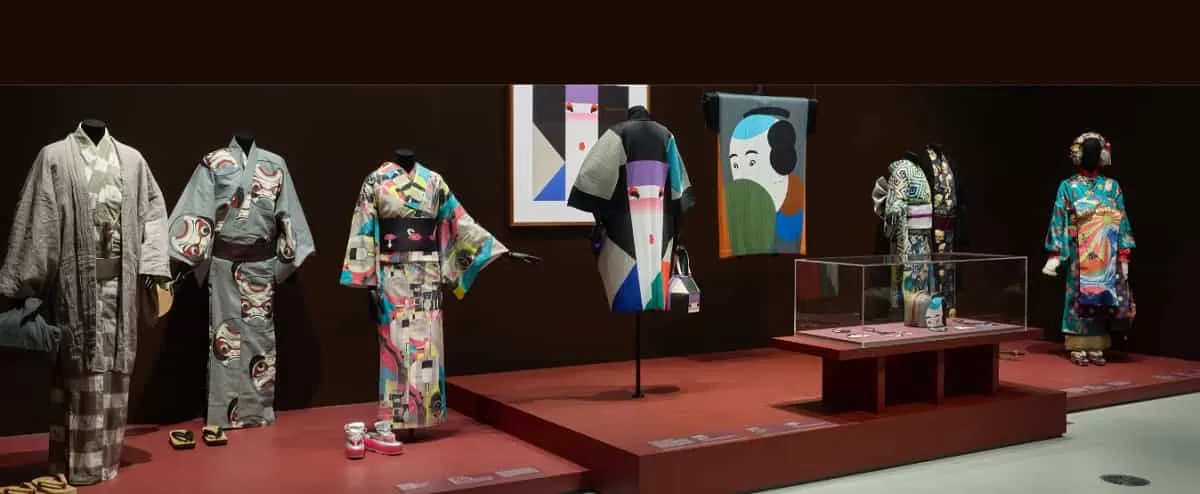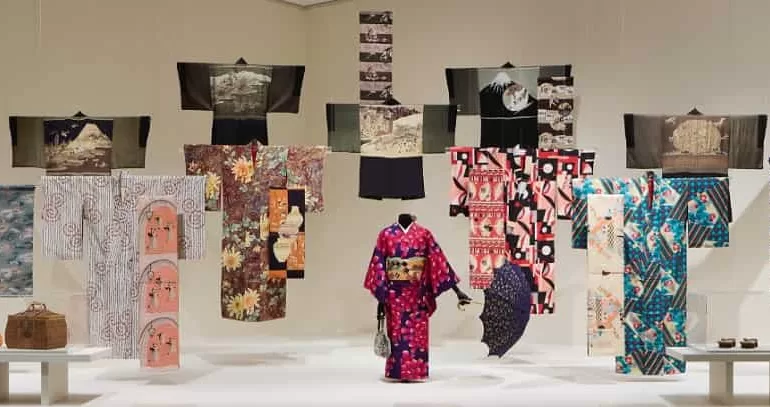ART
From samurai silk to Harajuku style, the NGV Kimono Exhibition traces the evolution of Japanese fashion, revealing rare historical garments and striking contemporary fashion.
BY KAZEEM ADELEKE, ARTCENTRON
MELBOURNE, AUSTRALIA-The National Gallery of Victoria (NGV) Kimono Exhibition is an opportunity to step into the rich tapestry of Japanese art and culture. This exhibition explores the important historical and cultural significance of Japan’s most emblematic garment. Spanning from the Edo period (1603–1868) to the present, the show reveals its artistic evolution, resonance in modern design, and enduring global influence on fashion and aesthetics. Over 70 luxurious and meticulously crafted kimonos form a comprehensive narrative of tradition, transformation, and innovation.
Exquisite Craftsmanship and Rare Garments
The landmark NGV Kimono exhibition showcases kimonos fashioned from the world’s finest silk and enhanced with opulent gold and silver embroidery. These garments depict natural landscapes, auspicious motifs, and seasonal elements with an artistry rarely seen outside Japan. Many pieces are new acquisitions for the NGV’s collection, which now boasts over 30 newly acquired kimonos, attesting to the gallery’s commitment to authentic cultural heritage. In all, the exhibition includes over 60 works from the NGV Collection. They include hand-crafted kimonos worn by Japanese shoguns, samurai, merchants, and performers. Together, they narrate the garment’s rich history by showcasing these holdings together for the first time.
Additionally, 150 related objects, including woodblock prints, decorative arts, vintage magazines, theatrical masks, lacquerware, and historic posters, are on display. Together, these materials enrich the context and deepen understanding of the kimono’s societal role and aesthetic significance through time. Kimono follows a loose chronology, exploring key themes in kimono fashion history, including children’s wear, modernism, and seasonal motifs. On display are diverse textile materials, including silk, cotton, hemp, and metallic thread. Other materials are paper, elm bark, banana tree fiber, and deer leather. The diversity and variety of materials highlights artisans’ diverse skills, including shibori tie-dye, rice paste resist designs, and indigo blue dyeing techniques.
From Edo Elegance to Contemporary Statements
The exhibition journey begins in the Edo period, presenting rare kimonos worn by samurai, merchants, and the aristocracy. Seven newly acquired Edo-era kimonos are standout highlights for the stunning exhibition. The exquisite designs are made from silk and ramie and detailed with motifs such as falling snow, maple leaves, and cascading wisteria. These pieces encapsulate the quiet sophistication and coded symbolism of 18th- and 19th-century Japan.
A traditional red wedding kimono, richly embroidered with bamboo, pine, and crane motifs, showcases the intricate shibori tie-dye technique. This beautiful design offers viewers a glimpse into historical Japanese bridal customs. The Kimono exhibition also includes a poignant piece of Japanese-Australian cultural heritage. This piece is a white wedding kimono gifted by the family of Funiko Saito, the former official embroiderer for the Japanese imperial family, based in Melbourne.
Contemporary Innovators and Global Fashion Influences
The NGV Kimono exhibition highlights the garment’s continuous evolution. It features works by historical artisans alongside contemporary Japanese designers such as Hiroko Takahashi, Jotaro Saito, Rumi Rock, and Robe Japonica. The global appeal of the kimono is evident, with representations from international fashion houses and designers including Issey Miyake, Yohji Yamamoto, John Galliano, Comme des Garçons, and Alexander McQueen. These visionaries redefine the kimono for modern lifestyles while staying rooted in traditional methods such as yuzen hand-stenciling and hand-painting. Designer Jotaro Saito, a third-generation Kyoto-based artisan, presents Australian-premiere works specially curated for NGV. Known for his dramatic yet wearable designs, Saito’s kimono ensembles fuse heritage with high fashion, spotlighting the garment’s adaptability in the 21st century.
Notably, the NGV Kimono Exhibition features Issey Miyake’s collaboration with Ikko Tanaka’s estate, where Tanaka’s iconic poster designs are reimagined on pleated haori coats. Yohji Yamamoto’s ensembles explore the juxtaposition of Japanese silhouettes and Western tailoring, creating hybrid styles that blur cultural boundaries.
NGV Kimono Exhibition: Rare Japanese Fashion

Influence and Impact on Western Fashion
The NGV Kimono Exhibition traces the kimono’s influence beyond Japan, highlighting Japonisme—the 19th-century Western fascination with Japanese art and design. This influence is visible in early 20th-century Western garments such as Liberty & Co. coats. These elements are also evident in pieces by Callot Soeurs and Paul Poiret. These two designers adapted the kimono’s form and fluidity into their haute couture collections.
Designs from the 1980s to the present reflect a renewed interest in Japanese aesthetics. Designers like John Galliano, Givenchy, Zambesi, Rudi Gernreich, and Alexander McQueen incorporate kimono sleeves, sashes, and wrap styles into contemporary garments, revealing the global and timeless appeal of the kimono silhouette. Australia’s own Akira Isogawa, a leading voice in fashion design, also contributed to the NGV Kimono Exhibition. His work seamlessly integrates kimono structures, traditional fabrics, and Japanese motifs, creating pieces both innovative and deeply respectful of heritage.
NGV Kimono Exhibition: Artistry, Techniques, and Textile Diversity
The NGV Kimono exhibition showcases the extraordinary skill of kimono artisans. It focuses on techniques such as shibori, yuzen, indigo dyeing, rice paste resist, and metallic thread embroidery. Among the showcased masters are Serizawa Keisuke, celebrated for his vibrant resist-dyed patterns, and Shimura Fukumi, a living national treasure known for her commitment to natural plant dyes and handwoven silk textiles. Their works represent the pinnacle of Japanese craftsmanship, attracting collectors and curators from across the globe, especially at the NGV Kimono Exhibition.
Theatrical Splendor at the NGV Kimono Exhibition
Another highlight of the NGV Kimono exhibition is the display of three ceremonial kimonos from the Noh and Kyogen theaters. The designs are rich with silver and gold brocade used in classical Japanese performances. These garments exemplify the theatrical opulence of sixteenth- and seventeenth-century nobility. They connect the kimono not only to fashion but also to storytelling, ritual, and spiritual expression. The exhibit includes performance masks, lacquerware, and swatches, creating an immersive, multidimensional presentation.
Public Engagement and Educational Programs
Colin Brooks, Minister for Creative Industries, expressed enthusiasm for the NGV’s continued celebration of Japanese culture, following the successful Yayoi Kusama exhibition. Brooks anticipates the NGV Kimono Exhibition will attract visitors and boost Melbourne’s economy. Tony Ellwood AM, Director, NGV, commented on the kimono’s iconic status, stating its timeless style embodies global fashion culture as an instantly recognizable symbol of Japan.
Accompanying the NGV Kimono Exhibition is Japanese Fashion & The Art of the Kimono. The event offered free spotlight talks. NGV curators and experts discussed the kimono’s influence. NGV Art School presented two new courses: “Art and the World: Japan.” This course is a four-part course exploring Japan’s cultural and artistic legacy. A hands-on Japanese textile workshop, “Japanese Washi & Textile Techniques,” introduced traditional techniques. During the workshop, participants were allowed to create textile work with washi paper, all in conjunction with the Kimono Exhibition.
